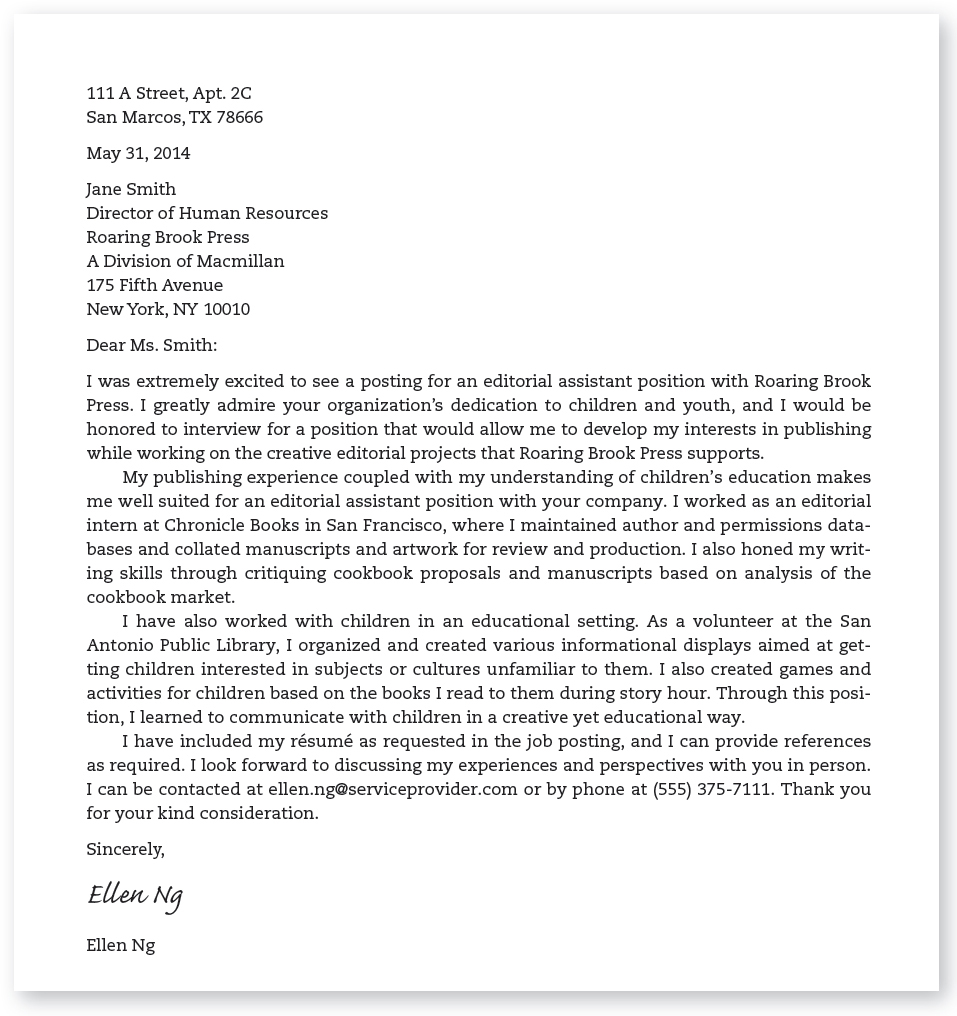Getting the Interview
Getting the Interview
Page 375
The first step involves actually getting the interview. This important phase involves three interrelated tasks: locating jobs and doing homework on the organizations, preparing materials to be used in the process (the résumé and cover letter), and building realistic expectations about the interviewing process.
The Job Search. The first element of preinterview preparation involves identifying potential jobs and then researching the field and the organizations. Although there are many strategies for locating jobs, your three best sources are likely to be people you know or manage to meet, placement centers, and discipline-specific job sites.
A great place to start is with family, friends, professors, former employers, and individuals working in your field of interest. You should also plan to network (Brazeel, 2009). Networking is the process of using interconnected groups or associations of persons you know to develop relationships with their connections that you don’t know. Contact everyone you know who works in your field or who might know someone who does, let these individuals know the kind of job you are looking for, and ask for suggestions. You can also make new contacts via social-networking services like Facebook and LinkedIn or through an organization for professionals in your chosen field (many offer student memberships).
Placement centers are another source of jobs. Most college campuses have a centralized placement center where recruiters from major companies come to interview potential employees.
Finally, start looking for specific job openings. While general employment Web sites (like Monster.com) can be starting places, they may not yield significant results simply because they attract a large number of applicants (J. O’Loughlin, personal communication, July 23, 2010). A more productive search uses sites that cater to specific industries or even an organization’s site (Pearce & Tuten, 2001; Young & Foot, 2005). For example, mediabistro.com and EntertainmentCareers.net focus on jobs in the media and entertainment industries. You can also find job postings on the Web sites for most major companies and organizations (look for links to “Careers” or “Employment”). Consider using job information and posting aggregators (such as LexisNexis) that will let you set criteria or parameters for the types or even geographic locations of positions you want. Doing so will put you in touch with sites that have less traffic and give you a better chance of being noticed.
Prepare Your Materials. Once you’ve identified potential jobs, you’ll need to make contact with the people in a position to hire you. As a job applicant, the crucial first impression you make on a potential employer will likely be via your written materials—a formal cover letter and résumé. In this section, we show you how to prepare these materials so that they communicate the right message about you.
Technology and You
Do you have an account with Facebook, Twitter, or some other social-networking site? Think objectively about the impression, if any, your public page conveys about you. Would you hire you?
But first, a cautionary note: before you send off these written materials, make sure you have cleaned up any searchable information that does not portray you in a favorable light (Brandenburg, 2008; Holson, 2010). If you use social-networking sites, adjust your privacy settings to ensure that you have not been, and cannot be, tagged in any photographs that you wouldn’t want a potential employer to see and that your wall is not visible to anyone other than your approved friends. Perform searches for your name and e-mail address to make sure that any comments you’ve left on public forums or chat rooms don’t come back to haunt you.
The résumé.
Begin by pulling together a résumé—a printed summary of your education, work experiences, and accomplishments. It is a vehicle for making a positive first impression on potential employers. An effective résumé tells just enough about you to make employers believe they may need your skills and experience.
No two résumés look exactly alike, but most résumés should contain the following general information:
- Contact information. Include both campus and home addresses if necessary, phone numbers, and your e-mail address. Make sure that your voice mail greets callers with a clear, professional message, and check it often. If you have an odd or a cute address for your regular e-mail (partygirl@provider.com, numberonedad@provider.net), consider opening another account with a more serious name for your professional communication.
- Employment objective. Be concise and specific about what you’re looking for in a position and your career goals. If you are applying for several types of jobs, you should create multiple résumés tailored to specific positions.
- Education. List the institutions you have attended, their locations, and the dates of attendance. List degrees received (or dates to be received), academic majors, and areas of concentration. Awards and GPA can be listed if they enhance your marketability.
- Work experience. If your work experiences are all in the same area, list them in reverse chronological order, focusing on concrete examples of achievement or skills that you have mastered. Explain job functions as well as titles. If, like many students, you have had a variety of jobs (for example, waiting tables and being a camp counselor), reverse chronological order may not be very practical. Consider grouping actual employment and volunteer activities together in a way that best matches the job responsibilities you are seeking. Remember that prospective employers read this section carefully to discover how your experience, abilities, and achievements relate to their organization’s needs.
- Activities. For employers, participation in a variety of academic, extracurricular, or social activities indicates that you are motivated and get involved. Include activities that are relevant to your career objective, emphasizing accomplishments and leadership roles—and link them clearly together.
- Special skills. Do you speak fluent Spanish? Are you skilled in a particular programming language? Did you climb Mount Everest? Don’t be shy—let potential employers know this information. Your skills may be useful to the organization, and your accomplishments show dedication and determination.
- References. Your references are typically professors, previous supervisors, or anyone else who can confirm your employment history and attest to your work ethic and character. You are not necessarily required to include your references as part of your résumé, but be sure to have their current contact information handy in case a hiring manager requests them. Be sure to include only people who have agreed to serve as references for you.
A sample résumé appears in Figure A.2.

Once your résumé is complete, take some time to prepare it for electronic submission. You can avoid translation issues by saving it as a PDF document, so that employers can read it regardless of what type of computer they have. You should also name the file carefully, so that employers will be able to identify it easily. Include your name (or just your last name) in the file title, along with the word resume and perhaps a date. For example, MartinezResumeJan2012.pdf is a title preferable to MyResume.pdf.
The cover letter.
Whenever you send your résumé to a potential employer, it should be accompanied by a formal cover letter, a one-page missive indicating your interest in a specific position. The cover letter gives you the opportunity to express how you learned of the position and the organization, how your skills and interests can benefit the organization, and why you are interested in applying for this particular job. The cover letter also serves as a means by which you can demonstrate your written communication skills, so make sure that you use correct grammar, punctuation, and spelling—and proofread carefully! Figure A.3 shows a strong cover letter.

THINGS TO TRY
Assess your goals for employment, and then design (or revise) a résumé for the job you are most interested in. Use the guidelines in this chapter to make it clear and action oriented. Prepare additional résumés for other positions, highlighting the aspects of your training and experience most relevant to each particular position. Discuss your résumé with other students in the class; ask them if your goals are clear. Can they tell what job you are seeking based on the different résumés you show them?

In many cases, prospective employers accept e-mails as cover letters. So when you e-mail a hiring manager or a human resources representative at an organization, your e-mail should contain the same information as your cover letter. If you are unsure of the protocol, it’s always best to be more formal and include an official cover letter with your e-mail. Be sure to include a subject line and to proofread your e-mail carefully before you press Send.
Build Realistic Expectations. The final component of job hunting involves developing realistic expectations about the process. Because only a few résumés will make it through the screening process and you will not be the only candidate who gets called for an interview, you will likely face rejection at least once during the course of a job search—either because there was a better-qualified applicant or because an equally qualified candidate had some advantage (such as a personal contact in the company). Remember that rejection is not uncommon and that it is the inevitable result of a tight job market and a less-than-perfect selection process (Fisk, 2010; Hershatter & Epstein, 2010; Lebo, 2009; Luo, 2010). Persistence pays. If you approach the job search intelligently and persistently, you will eventually get a job.
Technology and You
Have you sent out more résumés electronically or on paper, or have you sent out both versions in equal numbers? Do you format your résumé differently when you are sending it electronically?